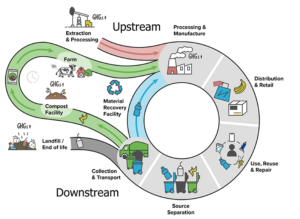
When I left my job as a conservation biologist in May to join GreenBiz, I had never heard the term “nature-positive” to refer to the effort to halt and reverse nature loss. I quickly learned that those who work in corporate sustainability talk about biodiversity in an entirely different dialect. Since then, as I planned our inaugural biodiversity event, Bloom 23, I’ve had a crash course in the lexicon and themes shaping the biodiversity conversation for business through hundreds of conversations with executives, investors, startups and academics.
If you’re looking to put your business at the forefront of biodiversity efforts, these are the five main topics you should know about, although there are major inconsistencies in how they’re typically discussed and applied.
Go ‘all-in’ on action, not just announcements
The term “nature positive” is now mainstream. But is it just an attempt to greenwash the continued degradation of land and water by the companies making these claims? To halt and reverse the loss of nature, philanthropic giving and feel-good restoration projects are not enough. We need companies to transform their supply chains and operations. We also need a drastic reduction in consumer consumption and waste. When I hear that a company donated millions towards a conservation project, I don’t automatically celebrate. Instead, I ask what that company is doing to directly reduce the impacts of its operations and products on people, biodiversity and climate.
Help close the $700 billion biodiversity funding gap
There’s a $700 billion gap between the current level of investment and the amount needed to meet global biodiversity targets. At least, that was the case in 2020 when the groundbreaking Financing Nature report was published. This price tag is already outdated and based on the United Nations Aichi Biodiversity Targets of 2010, but the number stuck. The core question is how to mobilize funds from the private sector, which traditionally accounted for only a small percentage of nature finance, while simultaneously increasing the flow of public funds. The most commonly cited financial mechanisms include natural capital, blended finance, debt-for-nature swaps and credit markets. While I’m excited to see nature being valued, I worry that our eagerness to throw more money at the problem will reinforce the colonial structures that got us here in the first place. The debt-for-nature market, for example, is expected to unlock more than $800 billionwhile giving wealthy lenders and environmental organizations tremendous power over some of the poorest countries in the Global South. As the money starts to flow, we need more transparency around where the funds are going, and who is actually benefiting.
Disclose corporate nature-related risks and dependencies
We’re about to watch a high-stakes global experiment play out in real-time. The hypothesis? Providing a standard for companies to disclose their nature-related risks and dependencies will lead to greater transparency and accountability. The few U.S.-based companies that are doing this are in the early stages of adopting the Taskforce on Nature-Related Financial Disclosures (TNFD) framework and are focused on assessing risks and opportunities, setting targets, and evaluating data gaps and availability. Other (mostly European) companies such as Bayer, BP, Enel, Holcim and Ørsted have already adopted and piloted both TNFD and science-based targets for nature. Ultimately, the fate of the framework depends on the willingness of investors and regulatory agencies to mandate and enforce it, which will take years. Given the groundswell of support for nature-positive initiatives, I’m optimistic that the path toward mandatory disclosures will be much shorter for biodiversity than it was for carbon.
Find the right biodiversity data
Everyone is talking about biodiversity data. They’re talking about the lack of standardization, poor quality and availability, and absence of established thresholds. Some are embracing the complexity while others are pushing for a standardized unit of measurement such as carbon is for climate targets. On one end of the spectrum, we have fine-scale biodiversity data such as Yale’s Map of Life providing users with high resolution species-specific information for a given location. On the other end, we have the U.K.’s aptly named Biodiversity Metric 4.0, a single standardized metric used to assess an area’s value to wildlife. As an ecologist who spent years collecting and deciphering complex data, I can tell you that simplified data will result in subpar results in most cases. At the end of the day, the most effective data depends on the scale of interest, the question at hand, and how practically it can be applied by the true end-user: the people and communities stewarding the land, water and natural resources.
Adopt regional approaches
In the world of conservation, there’s a tension between protecting and managing individual species and habitats versus entire landscapes. Most major environmental organizations have adopted the landscape approach by now, recognizing that engagement with multiple stakeholders across strategically connected ecosystems is more effective than a patchwork of protected areas. It makes sense that corporate biodiversity strategies would follow suit. After all, individual supply chains exist within a larger ecosystem of natural resources and societal needs. According to a recent scoping study the top reasons companies engage in landscape approaches include managing community and operational risks, and achieving value chain efficiency and compliance with voluntary standards. Right now, the most common mechanisms being used for landscape approaches are finance-based (such as carbon credits and water funds). In the coming years, I’ll be watching for examples that go beyond this for radical collaboration and supply chain transparency.
Several critical topics remain seemingly overlooked: collaboration with Indigenous groups, the protection and restoration of biodiversity in urban environments and biodiversity-focused ocean strategies. I’ll be talking and writing more about all three in the coming days and weeks.
- SEO Powered Content & PR Distribution. Get Amplified Today.
- PlatoData.Network Vertical Generative Ai. Empower Yourself. Access Here.
- PlatoAiStream. Web3 Intelligence. Knowledge Amplified. Access Here.
- PlatoESG. Carbon, CleanTech, Energy, Environment, Solar, Waste Management. Access Here.
- PlatoHealth. Biotech and Clinical Trials Intelligence. Access Here.
- Source: https://www.greenbiz.com/article/5-nature-trends-starting-shape-business-2023
- :is
- :not
- :where
- 2010
- 2020
- 2023
- 8
- a
- About
- academics
- According
- accountability
- accounted
- achieving
- across
- Action
- actually
- adopted
- Adopting
- After
- agencies
- All
- already
- also
- Although
- amount
- an
- analysis
- and
- applied
- approach
- approaches
- ARE
- areas
- around
- article
- AS
- ask
- assess
- Assessing
- At
- attempt
- automatically
- availability
- based
- Bayer
- BE
- being
- benefiting
- between
- Beyond
- Billion
- Blog
- Bloomberg
- both
- BP
- business
- business news
- but
- by
- CAN
- capital
- carbon
- carbon credits
- case
- cases
- celebrate
- chain
- chains
- cited
- claims
- Climate
- Close
- collaboration
- Collecting
- coming
- Common
- commonly
- Communities
- community
- Companies
- company
- complex
- complexity
- compliance
- connected
- CONSERVATION
- consumer
- consumption
- continued
- Conversation
- conversations
- Core
- Corporate
- countries
- course
- Crash
- credit
- Credits
- critical
- Current
- data
- day
- Days
- dependencies
- depends
- different
- directly
- Disclose
- Disclosures
- discussed
- doing
- Dont
- Early
- ecosystem
- Ecosystems
- Effective
- efficiency
- effort
- efforts
- embracing
- end
- enforce
- engage
- engagement
- enough
- Entire
- entirely
- environmental
- environments
- established
- Ether (ETH)
- European
- evaluating
- Event
- example
- examples
- excited
- executives
- exist
- expected
- experiment
- fate
- few
- finance
- financial
- First
- five
- flow
- focused
- follow
- For
- forefront
- Framework
- Free
- from
- funding
- funds
- gap
- gaps
- given
- Giving
- Global
- Go
- going
- got
- greater
- groundbreaking
- Group’s
- had
- hand
- Have
- hear
- heard
- here
- High
- How
- How To
- HTTPS
- Hundreds
- i
- I’LL
- Impacts
- in
- Inaugural
- include
- inconsistencies
- increasing
- individual
- information
- initiatives
- instead
- interest
- interested
- investment
- Investors
- IT
- ITS
- Job
- join
- jpg
- just
- Know
- Lack
- Land
- landscape
- larger
- latest
- lead
- learned
- learning
- least
- left
- lenders
- Level
- location
- looking
- loss
- Main
- Mainstream
- major
- MAKES
- Making
- managing
- mandate
- mandatory
- map
- Market
- Markets
- May..
- measurement
- mechanisms
- Meet
- metric
- millions
- mobilize
- money
- more
- most
- mostly
- much
- multiple
- my
- Named
- Nations
- Natural
- Nature
- Need
- needed
- needs
- never
- news
- Newsletter
- node
- now
- number
- ocean
- of
- on
- ONE
- only
- operational
- Operations
- opportunities
- Optimistic
- organizations
- Other
- Others
- our
- out
- over
- path
- People
- percentage
- philanthropic
- piloted
- Place
- planned
- plato
- Plato Data Intelligence
- PlatoData
- Play
- poor
- power
- practically
- price
- private
- private sector
- Problem
- Products
- project
- projects
- protected
- protecting
- protection
- providing
- public
- published
- Pushing
- put
- quality
- question
- quickly
- radical
- real-time
- reasons
- recognizing
- reduce
- reduction
- refer
- regional
- regulatory
- reinforce
- remain
- report
- Resolution
- Resources
- restoration
- result
- Results
- reverse
- right
- risks
- s
- Scale
- Scoping
- sector
- see
- sense
- setting
- Shape
- shaping
- should
- simplified
- simultaneously
- since
- single
- small
- societal
- some
- South
- Spectrum
- spent
- stages
- stakeholders
- standard
- standardization
- standards
- Starting
- starts
- Startups
- Strategically
- strategies
- structures
- such
- Suit
- supply
- supply chain
- supply chain transparency
- Supply chains
- support
- Sustainability
- sustainable
- Swaps
- TAG
- Take
- Talk
- talking
- targets
- tell
- term
- than
- that
- The
- The Landscape
- the world
- their
- themes
- then
- There.
- These
- this
- those
- three
- Through
- to
- top
- Topics
- toward
- towards
- traditionally
- Transform
- Transparency
- tremendous
- Trends
- true
- typically
- Ultimately
- unit
- United
- united nations
- unlock
- urban
- us
- used
- users
- value
- valued
- Versus
- voluntary
- was
- Waste
- Watch
- watching
- Water
- we
- wealthy
- weekly
- Weeks
- What
- when
- which
- while
- WHO
- Wildlife
- will
- Willingness
- with
- within
- Work
- world
- worry
- would
- writing
- years
- you
- Your
- zephyrnet







